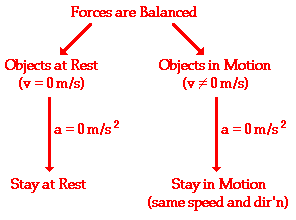1. a stationary objects to start moving (Movement)
2. Moving object to accelerate (Acceleration)
3. Moving object to decelerate (Deceleration)
4. Moving object to change direction(Direction)
Easy to remember:
Movement
Acceleration
Deceleration
Direction
*
Zero acceleration refers to objects that are stationary or moving with constant
velocity.In this case, different forces acting on it are balanced,add up to zero,
resultant or net force add up to zero.
Newton and his laws of motion
Isaac Newton (a 17th century scientist) put forth a variety of laws which explain why objects move (or don't move) as they do. These three laws have become known as Newton's three laws of motion.
Newton's First Law of motion(sometimes referred to as the law of inertia):
An object at rest tends to stay at rest and an object in motion tends to stay in motion with the same speed and in the same direction unless acted upon by an unbalanced force.
There are two parts to this statement - one which predicts the behavior of stationary objects and the other which predicts the behavior of moving objects. The two parts are summarized in the following diagram.

Example:
Suppose that you filled a baking dish to the rim with water and walked around an oval track making an attempt to complete a lap in the least amount of time. The water would have a tendency to spill from the container during specific locations on the track. In general the water spilled when:
* the container was at rest and you attempted to move it
* the container was in motion and you attempted to stop it
* the container was moving in one direction and you attempted to change its
direction.
The water spills whenever the state of motion of the container is changed. The water
resisted this change in its own state of motion.The container was moved from rest to a high speed at the starting line; the water remained at rest and spilled onto the table. The container was stopped near the finish line; the water kept moving and spilled over container's leading edge. The container was forced to move in a different direction to make it around a curve; the water kept moving in the same direction and spilled over its edge. The behavior of the water during the lap around the track can be explained by Newton's first law of motion.(Water keeps on doing what its doing)
More Examples:
*
Blood rushes from your head to your feet while quickly stopping when
riding on a descending elevator.
*
The head of a hammer can be tightened onto the wooden handle by banging the
bottom of the handle against a hard surface.
*
A brick is painlessly broken over the hand of a physics teacher by slamming it
with a hammer. (CAUTION: do not attempt this at home!)
*
To dislodge ketchup from the bottom of a ketchup bottle, it is often turned
upside down and thrusted downward at high speeds and then abruptly halted.
*
Headrests are placed in cars to prevent whiplash injuries during rear-end
collisions.
*
While riding a skateboard (or wagon or bicycle), you fly forward off the board
when hitting a curb or rock or other object which abruptly halts the motion of
the skateboard.
No comments:
Post a Comment